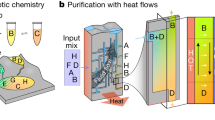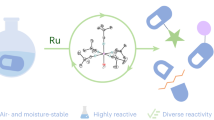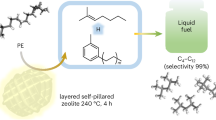Abstract
Solvent-free chemical manufacturing is one of the awaited technologies for addressing an emergent issue of environmental pollution. Here, we report solvent-free autocatalytic supramolecular polymerization (SF-ASP), which provides an inhibition-free template-assisted catalytic organic transformation that takes great advantage of the fact that the product (template) undergoes a termination-free nucleation–elongation assembly (living supramolecular polymerization) under solvent-free conditions. SF-ASP allows for reductive cyclotetramerization of hydrogen-bonding phthalonitriles into the corresponding phthalocyanines in exceptionally high yields (>80%). SF-ASP requires the growing polymer to form hexagonally packed crystalline fibres, which possibly preorganize the phthalonitriles at their cross-sectional edges for their efficient transformation. With metal oleates, SF-ASP produces single-crystalline fibres of metallophthalocyanines again in exceptionally high yields, which grow in both directions without terminal coupling until the phthalonitrile precursors are completely consumed. By taking advantage of this living nature of polymerization, multistep SF-ASP without/with metal oleates allows for the precision synthesis of multi-block supramolecular copolymers.
This is a preview of subscription content, access via your institution
Access options
Access Nature and 54 other Nature Portfolio journals
Get Nature+, our best-value online-access subscription
$29.99 / 30 days
cancel any time
Subscribe to this journal
Receive 12 print issues and online access
$259.00 per year
only $21.58 per issue
Buy this article
- Purchase on Springer Link
- Instant access to full article PDF
Prices may be subject to local taxes which are calculated during checkout




Similar content being viewed by others
Data availability
Data generated or analysed during this study are provided as source data or included in the Supplementary Information. Further data are available from the corresponding authors on request. Source data are provided with this paper.
References
Lau, W. W. Y. et al. Evaluating scenarios towards zero plastic pollution. Science 369, 1455–1461 (2020).
Aida, T., Meijer, E. W. & Stupp, S. I. Functional supramolecular polymers. Science 335, 813–817 (2012).
Aida, T. & Meijer, E. W. Supramolecular polymers–we’ve come full circle. Isr. J. Chem. 60, 33–47 (2020).
De Greef, T. F. A. et al. Supramolecular polymerization. Chem. Rev. 109, 5687–5754 (2009).
Besenius, P. Controlling supramolecular polymerization through multicomponent self-assembly. J. Polym. Sci. A.: Polym. Chem. 55, 34–78 (2017).
Hashim, P. K., Bergueiro, J., Meijer, E. W. & Aida, T. Supramolecular polymerization: a conceptual expansion for innovative materials. Prog. Polym. Sci. 105, 101250 (2020).
Tanaka, K. & Toda, F. Solvent-free organic synthesis. Chem. Rev. 100, 1025–1074 (2000).
Zimmerman, J. B., Anastas, P. T., Erythropel, H. C. & Leitner, W. Designing for a green chemistry future. Science 367, 397–400 (2020).
Zerkowski, J. A., Seto, C. T., Wierda, D. A. & Whitesides, G. M. Design of organic structures in the solid state: hydrogen-bonded molecular ‘tapes’. J. Am. Chem. Soc. 112, 9025–9026 (1990).
Fouquey, C., Lehn, J. M. & Levelut, A. M. Molecular recognition directed self-assembly of supramolecular liquid crystalline polymers from complementary chiral components. Adv. Mater. 2, 254–257 (1990).
Lee, C. M., Jariwala, C. P. & Griffin, A. C. Heteromeric liquid-crystalline association chain polymers: structure and properties. Polymer 35, 4550–4554 (1994).
Rao, K. V., Miyajima, D., Nihonyanagi, A. & Aida, T. Thermally bisignate supramolecular polymerization. Nat. Chem. 9, 1133–1139 (2017).
Van Zee, N. J. et al. Potential enthalpic energy of water in oils exploited to control supramolecular structure. Nature 558, 100–103 (2018).
Datta, S. et al. Self-assembled polycatenanes from supramolecular toroidal building blocks. Nature 583, 400–405 (2020).
Bissette, A. J. & Fletcher, S. P. Mechanism of autocatalysis. Angew. Chem. Int. Ed. 52, 12800–12826 (2013).
Schrodinger, E. What Is Life?—The Physical Aspect of the Living Cell (Cambridge Univ. Press, 1944).
Robertson, M. P. & Joyce, G. F. The origins of the RNA world. Cold Spring Harb. Perspect. Biol. 4, a003608 (2012).
Orgel, L. E. Molecular replication. Nature 358, 203–209 (1992).
Lee, D. H., Granja, J. R., Martinez, J. A., Severin, K. & Ghadiri, M. R. A self-replicating peptide. Nature 382, 525–528 (1996).
Paul, N. & Joyce, G. F. A self-replicating ligase ribozyme. Proc. Natl Acad. Sci. USA 99, 12733–12740 (2002).
Robertson, A., Sinclair, A. J. & Philp, D. Minimal self-replicating systems. Chem. Soc. Rev. 29, 141–152 (2000).
Vidonne, A. & Philp, D. Making molecules make themselves—the chemistry of artificial replicators. Eur. J. Org. Chem. 2009, 593–610 (2009).
Carnall, J. M. A. et al. Mechanosensitive self-replication driven by self-organization. Science 327, 1502–1506 (2010).
Colomb-Delsuc, M., Mattia, E., Sadownik, J. W. & Otto, S. Exponential self-replication enabled through a fibre elongation/breakage mechanism. Nat. Commun. 6, 7274 (2015).
Takahashi, Y. & Mihara, H. Construction of a chemically and conformationally self-replicating system of amyloid-like fibrils. Bioorg. Med. Chem. 12, 693–699 (2004).
Rubinov, B., Wathaniel, W., Rapaport, H. & Ashkenasy, G. Self-replicating amphiphilic β-sheet peptides. Angew. Chem. Int. Ed. 48, 6683–6686 (2009).
Rubinov, B. et al. Transient fibril structures facilitating nonenzymatic self-replication. ACS Nano 6, 7893–7901 (2012).
Thrümer, K., Williams, E. & Reutt-Robey, J. Autocatalytic oxidation of lead crystalline surface. Science 297, 2033–2035 (2002).
Liu, Q. et al. Quantifying the nucleation and growth kinetics of microwave nanochemistry enabled by in situ high-energy X-ray scattering. Nano Lett. 16, 715–720 (2016).
Morrow, S. M., Colomer, I. & Fletcher, S. P. A chemically fueled self-replicator. Nat. Commun. 10, 1011 (2019).
Semenov, S. N. et al. Autocatalytic, bistable, oscillatory networks of biologically relevant organic reactions. Nature 537, 656–660 (2016).
Colomer, I., Morrow, S. M. & Fletcher, S. P. A transient self-assembling self-replicator. Nat. Commun. 9, 2239 (2018).
Kumar, M. et al. Amino-acid-encoded biocatalytic self-assembly enables the formation of transient conducting nanostructures. Nat. Chem. 10, 696–703 (2018).
Epstein, I. R. & Xu, B. Reaction-diffusion processes at the nano- and microscales. Nat. Nanotechnol. 11, 312–319 (2016).
Miyajima, D. et al. Ferroelectric columnar liquid crystal featuring confined polar groups within core-shell architecture. Science 336, 209–213 (2012).
Klapperich, C., Komvopoulos, K. & Pruitt, L. Nanomechanical properties of polymers determined from nanoindentation experiments. J. Tribol. 123, 624–631 (2001).
Kadish, K. M., Smith, K. M. & Guilard, R. The Porphyrin Handbook: Phthalocyanine: Synthesis (Academic Press, 2003).
Narayanasamy, J. & Kubichi, J. D. Mechanism of hydroxyl radical generation from a silica surface: molecular orbital calculations. J. Phys. Chem. B 109, 21796–21807 (2005).
Gierada, M., Proft, F. D., Sulpizi, M. & Tielens, F. Understanding the acidic properties of the amorphous hydroxylated silica surface. J. Phys. Chem. C. 123, 17343–17352 (2019).
Inabe, T. & Tajima, H. Phthalocyanines—versatile components of molecular conductors. Chem. Rev. 104, 5503–5533 (2004).
Sorokin, A. B. Phthalocyanine metal complexes in catalysis. Chem. Rev. 113, 8152–8191 (2013).
Melville, O. A., Lessard, B. H. & Bender, T. P. Phthalocyanine-based organic thin-film transistors: a review of recent advances. ACS Appl. Mater. Interfaces 7, 13105–13118 (2015).
Wang, X. et al. Cylindrical block copolymer micelles and co-micelles of controlled length and architecture. Science 317, 644–647 (2007).
Ogi, S., Sugiyasu, K., Manna, S., Samitsu, S. & Takeuchi, M. Living supramolecular polymerization realized through a biomimetic approach. Nat. Chem. 6, 188–195 (2014).
Kang, J. et al. A rational strategy for the realization of chain-growth supramolecular polymerization. Science 347, 646–651 (2015).
Wehner, M. & Würthner, F. Supramolecular polymerization through kinetic pathway control and living chain growth. Nat. Rev. Chem. 4, 38–53 (2020).
Zhang, Y. et al. Organic single-crystalline p-n junction nanoribbons. J. Am. Chem. Soc. 132, 11580–11584 (2010).
Zhang, W. et al. Supramolecular linear heterojunction composed of graphite-like semiconducting nanotubular segments. Science 334, 340–343 (2011).
Wu, J., Li, Q., Xue, G., Chen, H. & Li, H. Preparation of single-crystalline heterojunctions for organic electronics. Adv. Mater. 29, 1606101 (2017).
Adolf, C. R. R., Ferlay, S. & Hosseini, M. W. Molecular tectonics: control of crystalline sequences. Cryst. Eng. Comm. 20, 2233–2236 (2018).
Miyajima, D. et al. Columnar liquid crystal with spontaneous polarization along the columnar axis. J. Am. Chem. Soc. 132, 8530–8531 (2010).
Terazzi, E. et al. Molecular control of macroscopic cubic, columnar, and lamellar organizations in luminescent lanthanide-containing thermotropic liquid crystals. J. Am. Chem. Soc. 127, 888–903 (2005).
Achalkumar, A. S. et al. Self-assembly of hekates-tris(n-salicylideneaniline)s into columnar structures: synthesis and characterization. J. Org. Chem. 78, 527–544 (2013).
Chiu, W. S. et al. Synthesis of two-dimensional ZnO nanopellets by pyrolysis of zinc oleate. Chem. Eng. J. 142, 337–343 (2008).
Bronstein, L. M. et al. Influence of iron oleate complex structure on iron oxide nanoparticle formation. Chem. Mater. 19, 3624–3632 (2007).
Buck, M. R., Biacchi, A. J. & Schaak, R. E. Insight into the thermal decomposition of Co(II) oleate for the shape-controlled synthesis of wurtzite-type CoO nanocrystals. Chem. Mater. 26, 1492–1499 (2014).
Clary, D. R. & Mills, G. Photochemical generation of nanometer-sized Cu particles in octane. J. Phys. Chem. C. 115, 14656–14663 (2011).
Wittmann, J. C. & Simth, P. Highly oriented thin films of poly-(tetrafluoroethylene) as a substrate for oriented growth of materials. Nature 352, 414–417 (1991).
Oliver, W. C. & Pharr, G. M. An improved technique for determining hardness and elastic modulus using load and displacement sensing indentation experiments. J. Mater. Res. 7, 1564–1568 (1992).
Liu, M. et al. An anisotropic hydrogel with electrostatic repulsion between cofacially aligned nanosheets. Nature 517, 68–72 (2015).
Acknowledgements
We thank C. Zhang (RIKEN) and H. Gong (The University of Tokyo) for their generous experimental support. This work was financially supported by the Japan Society for the Promotion of Science (JSPS) through its Grants-in-Aid for Specially Promoted Research (25000005) on ‘Physically Perturbed Assembly for Tailoring High-Performance Soft Materials with Controlled Macroscopic Structural Anisotropy’ for T.A. D.M. thanks JSPS for a Young Scientist A (grant no. 15H05487) and Coordination Asymmetry (grant no. JP17H05394).
Author information
Authors and Affiliations
Contributions
Z.C. designed and preformed all experiments. Y.S., A.I. and X.J. designed and assisted partial experiments and analysed the data. K.V.R., Y.O., E.S. and A.N. performed partial synthetic experiments. D.M. and T.A. conceived the project and codesigned the experiments. Z.C., D.M. and T.A. analysed the data and wrote the paper.
Corresponding authors
Ethics declarations
Competing interests
The authors declare no competing interests.
Additional information
Peer review information Nature Materials thanks the anonymous reviewers for their contribution to the peer review of this work.
Publisher’s note Springer Nature remains neutral with regard to jurisdictional claims in published maps and institutional affiliations.
Supplementary information
Supplementary Information
Supplementary Figs. 1–23, Tables 1–4, Videos 1 and 2 and Methods.
Supplementary Video 1
SF-ASP using PNC4 sandwiched between glass plates on heating at 160 °C, where the green-coloured thin fibres form.
Supplementary Video 2
SF-ASP using PNC4 in the presence of crystalline fibres of [HPCC4]CF as the seed sandwiched between CYTOP-coated glass plates on heating at 160 °C for 5 h, where the crystalline fibres elongate immediately.
Source data
Source Data Fig. 2
a, Time-dependent absorption changes at 700 nm of HPCs. b, Temperature effect on the yields of HPCC4. d, MALDI–TOF mass spectrometry data.
Source Data Fig. 3
b, PXRD data. f, Polarized infrared data.
Source Data Fig. 4
a, Time-dependent absorption changes at 700 nm of MPCC4.
Rights and permissions
About this article
Cite this article
Chen, Z., Suzuki, Y., Imayoshi, A. et al. Solvent-free autocatalytic supramolecular polymerization. Nat. Mater. 21, 253–261 (2022). https://doi.org/10.1038/s41563-021-01122-z
Received:
Accepted:
Published:
Issue Date:
DOI: https://doi.org/10.1038/s41563-021-01122-z
This article is cited by
-
Differential perovskite hemispherical photodetector for intelligent imaging and location tracking
Nature Communications (2024)
-
Supramolecular assembly guided by photolytic redox cycling
Nature Synthesis (2023)
-
Precise Supramolecular Polymerization of Liquid Crystalline Block Copolymer Initiated by Heavy Metallic Salts
Chinese Journal of Polymer Science (2022)



